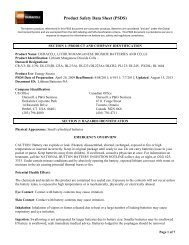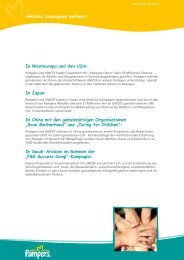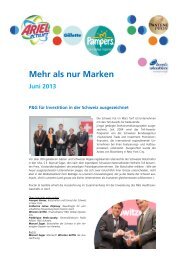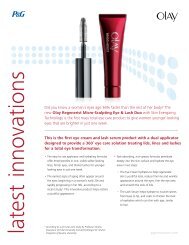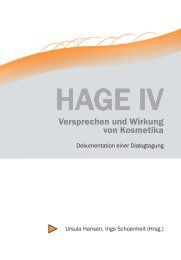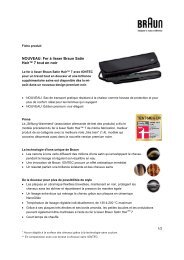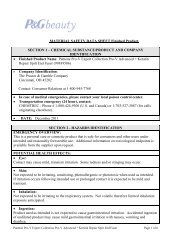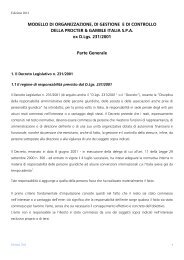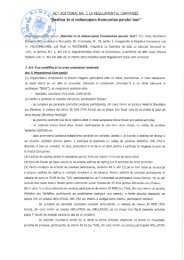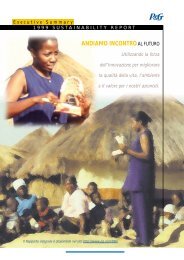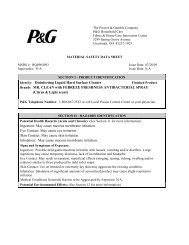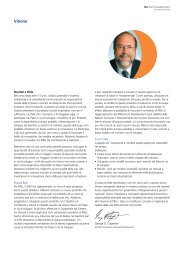P&G 2009 Annual Report – AnnualReports.com - Procter & Gamble
P&G 2009 Annual Report – AnnualReports.com - Procter & Gamble
P&G 2009 Annual Report – AnnualReports.com - Procter & Gamble
You also want an ePaper? Increase the reach of your titles
YUMPU automatically turns print PDFs into web optimized ePapers that Google loves.
46 The <strong>Procter</strong> & <strong>Gamble</strong> Company Management’s Discussion and Analysis<br />
$50 million. The average discount rate on the OPEB plan of 6.4%<br />
reflects the higher interest rates generally applicable in the U.S., which<br />
is where a majority of the plan participants receive benefits. A 0.5%<br />
change in the discount rate would impact annual after-tax OPEB<br />
expense by less than $20 million.<br />
Certain defined contribution pension and OPEB benefits in the U.S. are<br />
funded by the Employee Stock Ownership Plan (ESOP), as discussed<br />
in Note 8 to the Consolidated Financial Statements.<br />
Acquisitions<br />
We account for acquired businesses using the purchase method of<br />
accounting. Under the purchase method, our Consolidated Financial<br />
Statements reflect the operations of an acquired business starting from<br />
the <strong>com</strong>pletion of the acquisition. In addition, the assets acquired<br />
and liabilities assumed must be recorded at the date of acquisition at<br />
their respective estimated fair values, with any excess of the purchase<br />
price over the estimated fair values of the net assets acquired<br />
recorded as goodwill.<br />
Significant judgment is required in estimating the fair value of intangible<br />
assets and in assigning their respective useful lives. Accordingly,<br />
we typically obtain the assistance of third-party valuation specialists<br />
for significant items. The fair value estimates are based on available<br />
historical information and on future expectations and assumptions<br />
deemed reasonable by management, but are inherently uncertain.<br />
We typically use an in<strong>com</strong>e method to estimate the fair value of<br />
intangible assets, which is based on forecasts of the expected future<br />
cash flows attributable to the respective assets. Significant estimates<br />
and assumptions inherent in the valuations reflect a consideration of<br />
other marketplace participants, and include the amount and timing of<br />
future cash flows (including expected growth rates and profitability),<br />
the underlying product or technology life cycles, economic barriers to<br />
entry, a brand’s relative market position and the discount rate applied<br />
to the cash flows. Unanticipated market or macroeconomic events<br />
and circumstances may occur, which could affect the accuracy or<br />
validity of the estimates and assumptions.<br />
Determining the useful life of an intangible asset also requires judgment.<br />
Certain brand intangibles are expected to have indefinite lives<br />
based on their history and our plans to continue to support and build<br />
the acquired brands. Other acquired brands are expected to have<br />
determinable useful lives. Our assessment as to brands that have an<br />
indefinite life and those that have a determinable life is based on a<br />
number of factors including <strong>com</strong>petitive environment, market share,<br />
brand history, underlying product life cycles, operating plans and the<br />
macroeconomic environment of the countries in which the brands<br />
are sold. Our estimates of the useful lives of determinable-lived<br />
intangibles, primarily including brands, technologies and customer<br />
relationships, are primarily based on these same factors. All of our<br />
acquired technology and customer-related intangibles are expected<br />
to have determinable useful lives.<br />
Other significant estimates associated with the accounting for acquisitions<br />
include exit costs. Provided certain criteria are met, exit costs<br />
related to acquired operations are treated as assumed liabilities. If<br />
those criteria are not met, the costs are treated as operating expenses<br />
of the <strong>com</strong>bined <strong>com</strong>pany as incurred. Exit costs, consisting primarily<br />
of severance costs, facility closure and other exit costs related to<br />
redundant manufacturing, selling, general and administrative functions,<br />
are based upon plans that have been <strong>com</strong>mitted to by management<br />
but which are subject to refinement. Significant estimates and<br />
assumptions inherent in the calculation of exit costs relate to the<br />
number of employees that will be terminated, future costs to operate<br />
and eventually vacate duplicate facilities and costs to terminate agreements.<br />
These estimates and assumptions may change as we execute<br />
approved plans. Decreases to the estimated costs are generally<br />
recorded as an adjustment to goodwill. Increases to the estimates are<br />
generally recorded as an adjustment to goodwill during the purchase<br />
price allocation period (generally within one year of the acquisition<br />
date) and as operating expenses thereafter. For acquisitions closed<br />
after June 30, <strong>2009</strong>, exit costs will no longer be treated as acquired<br />
liabilities. Rather, they will be charged to expense as incurred post<br />
acquisition in accordance with the applicable new accounting guidance<br />
(see discussion of the new business <strong>com</strong>binations accounting guidance<br />
in the New Accounting Pronouncements section below).<br />
Goodwill and Intangible Assets<br />
Acquired intangible assets may represent indefinite-lived assets<br />
(e.g., certain trademarks or brands), determinable-lived intangibles<br />
(e.g., certain trademarks or brands, customer relationships, patents<br />
and technologies) or residual goodwill. Of these, only the costs of<br />
determinable-lived intangibles are amortized to expense over their<br />
estimated life. The value of indefinite-lived intangible assets and<br />
residual goodwill is not amortized, but is tested at least annually for<br />
impairment. Our impairment testing for goodwill is performed<br />
separately from our impairment testing of indefinite-lived intangibles.<br />
We test goodwill for impairment, at least annually, by reviewing the<br />
book value <strong>com</strong>pared to the fair value at the reportable unit level.<br />
We test individual indefinite-lived intangibles at least annually by<br />
reviewing the individual book values <strong>com</strong>pared to the fair value. We<br />
determine the fair value of our reporting units based on the in<strong>com</strong>e<br />
approach. Under the in<strong>com</strong>e approach, we calculate the fair value of<br />
our reporting units based on the present value of estimated future<br />
cash flows. Considerable management judgment is necessary to<br />
evaluate the impact of operating and macroeconomic changes and<br />
to estimate future cash flows to measure fair value. Assumptions used<br />
in our impairment evaluations, such as forecasted growth rates and<br />
cost of capital, are consistent with internal projections and operating<br />
plans. We believe such assumptions and estimates are also <strong>com</strong>parable<br />
to those that would be used by other marketplace participants. When<br />
certain events or changes in operating conditions occur, indefinitelived<br />
intangible assets may be reclassified to a determinable life asset<br />
and an additional impairment assessment may be performed. We<br />
did not recognize any material impairment charges for goodwill or<br />
intangible assets during the years presented.



